
Wetenschap
Hoe laat je een waarschuwing achter die net zo lang duurt als kernafval?
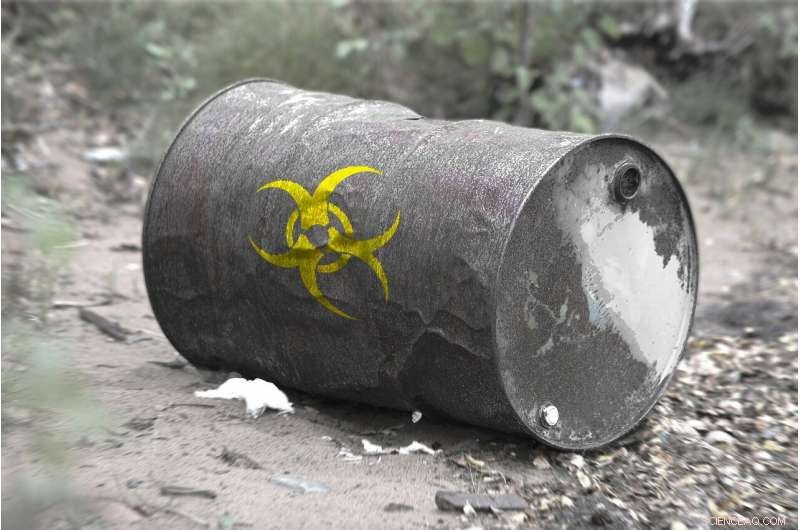
Krediet:CC0 Publiek Domein
In januari 1997, de bemanning van een vissersvaartuig in de Oostzee vond iets ongewoons in hun netten:een vettige geelbruine klomp kleiachtig materiaal. Ze hebben het eruit gehaald, plaatste het aan dek en keerde terug naar het verwerken van hun vangst. De volgende dag, de bemanning werd ziek met ernstige brandwonden. Vier werden in het ziekenhuis opgenomen. De vettige klomp was een stof genaamd yperite, beter bekend als zwavelmosterd of mosterdgas, gestold door de temperatuur op de zeebodem.
Aan het einde van de Tweede Wereldoorlog, de VS, Brits, De Franse en Sovjet-autoriteiten stonden voor een groot probleem:hoe zich te ontdoen van zo'n 300, 000 ton chemische munitie teruggevonden in bezet Duitsland. Vaak, ze kozen voor wat het veiligst leek, goedkoopste en gemakkelijkste methode:de spullen op zee dumpen.
Schattingen zijn dat ten minste 40, 000 ton chemische munitie werd verwijderd in de Oostzee, niet alles in aangewezen stortplaatsen. Sommige van deze locaties zijn aangegeven op scheepvaartkaarten, maar uitgebreide gegevens over wat er precies is gedumpt en waar, bestaat niet. Dit vergroot de kans op trawlerbemanningen, en anderen, in contact komen met dit gevaarlijke afval.
Het probleem gaat niet weg, vooral met het toegenomen gebruik van de zeebodem voor economische doeleinden, inclusief pijpleidingen, zeekabels en offshore windparken.
Het verhaal van die ongelukkige vissers illustreert twee punten. Eerst, het is moeilijk te voorspellen hoe toekomstige generaties zich zullen gedragen, wat ze zullen waarderen en waar ze naartoe willen. Tweede, creëren, het bijhouden en verzenden van gegevens over waar afval wordt gedumpt, is essentieel om toekomstige generaties te helpen zichzelf te beschermen tegen de beslissingen die we vandaag nemen. Beslissingen die onder meer betrekking hebben op de verwijdering van enkele van de meest gevaarlijke materialen van vandaag:hoogradioactief afval van kerncentrales.
De rode metalen lift doet er zeven huiveringwekkende minuten over om bijna 500 meter naar beneden te reizen. Omlaag, omlaag door romige kalksteen om een 160 miljoen jaar oude kleilaag te bereiken. Hier, diep onder de slaperige velden en stille bossen langs de grens van de departementen Maas en Haute-Marne in het noordoosten van Frankrijk, het Franse Nationale Agentschap voor het beheer van radioactief afval (Andra) heeft zijn ondergronds onderzoekslaboratorium gebouwd.
De tunnels van het laboratorium zijn helder verlicht, maar grotendeels verlaten, de lucht droog en stoffig en gevuld met het gezoem van een ventilatie-unit. Blauwe en grijze metalen dozen bevatten een reeks lopende experimenten - meten, bijvoorbeeld, de corrosiesnelheid van staal, de duurzaamheid van beton in contact met de klei. Met behulp van deze informatie, Andra wil hier een immens netwerk van tunnels aanleggen.
Het is van plan om deze plaats Cigéo te noemen, en om het te vullen met gevaarlijk radioactief afval. Het is ontworpen om 80, 000 kubieke meter afval.
We worden elke dag blootgesteld aan straling. Public Health England schat dat in een typisch jaar iemand in het VK een gemiddelde dosis van 2,7 millisievert (mSv) kan ontvangen van natuurlijke en kunstmatige stralingsbronnen. Een transatlantische vlucht, bijvoorbeeld, stelt u bloot aan 0,08 mSv; een tandheelkundige röntgenfoto tot 0,005 mSv; 100 gram paranoten tot 0,01 mSv.
Bij hoogradioactief afval ligt dat anders. Het is, in de eerste plaats, verbruikte splijtstof van kernreactoren of de residuen die vrijkomen bij de opwerking van die splijtstof. Dit afval is zo krachtig dat het van mensen moet worden geïsoleerd tot het stralingsniveau, die in de loop van de tijd afnemen, zijn niet langer gevaarlijk. De tijdschaal waar Andra naar kijkt, loopt op tot een miljoen jaar. (Om dit in een soort context te plaatsen, het is pas 4, 500 jaar geleden dat Stonehenge werd gebouwd. Rond de 40, 000 jaar geleden, moderne mensen arriveerden in Noord-Europa. Een miljoen jaar geleden, het continent bevond zich midden in een ijstijd. Mammoeten zwierven door het bevroren landschap.)
Sommige wetenschappers noemen dit langlevende afval "de achilleshiel van kernenergie, " en het is een probleem voor ons allemaal - wat ons standpunt over kernenergie ook is. Zelfs als alle kerncentrales van de wereld morgen zouden stoppen met werken, we zouden nog steeds meer dan 240 hebben, 000 ton gevaarlijk radioactief materiaal te verwerken.
Momenteel, kernafval wordt bovengronds of nabij het oppervlak opgeslagen, maar binnen de industrie wordt dit niet als een acceptabele langetermijnoplossing beschouwd. Zo'n opslagvoorziening vraagt om actieve monitoring. Naast regelmatige renovatie moet het worden beschermd tegen allerlei gevaren, inclusief aardbevingen, branden, overstromingen en opzettelijke aanvallen door terroristen of vijandelijke mogendheden.
Dit legt niet alleen een oneerlijke financiële last op onze nakomelingen, die misschien zelfs geen kernenergie meer gebruiken, maar gaat er ook vanuit dat er in de toekomst altijd mensen zullen zijn met de kennis en de wil om het afval in de gaten te houden. Op een tijdschaal van een miljoen jaar kan dit niet worden gegarandeerd.
Dus, na het overwegen van een reeks opties, regeringen en de nucleaire industrie zijn tot het inzicht gekomen dat diepe, geologische opslagplaatsen zijn de beste langetermijnaanpak. Het bouwen van een van deze is een enorme taak die gepaard gaat met tal van complexe veiligheidsproblemen.
Finland is al begonnen met de bouw van een geologische opslagplaats (Onkalo genaamd), en Zweden is begonnen met het licentieproces voor zijn site. Andra verwacht binnen twee jaar de bouwvergunning aan te vragen.
Als Cigéo in gebruik wordt genomen, zal het zowel het hoogactief afval als het zogenaamde middelactief langlevend afval huisvesten, zoals reactorcomponenten. Zodra de opslagcapaciteit zijn capaciteit heeft bereikt, over misschien 150 jaar, de toegangstunnels worden opgevuld en afgesloten. Als alles volgens plan verloopt, niemand zal ooit nog de repository binnengaan.
Ga voor een onafgeschermde stralingsbron staan en je ziet of voelt niets. Echter, een deel van die straling zal in je lichaam terechtkomen. Nucleair afval is gevaarlijk omdat het ioniserende straling uitzendt in de vorm van alfa- en bètadeeltjes en gammastraling. Hoewel alfadeeltjes te zwak zijn om door de huid te dringen, bètadeeltjes kunnen brandwonden veroorzaken. Indien ingenomen, beide kunnen interne weefsels en organen beschadigen.
Het zijn gammastralen, echter, die het grootste penetratiebereik hebben, en daardoor het potentieel om de meest wijdverbreide schade aan het DNA van uw cellen te veroorzaken. Deze schade kan op latere leeftijd leiden tot een verhoogd risico op kanker, en het is grotendeels verantwoordelijk voor de reeks symptomen die bekend staat als stralingsziekte.
Sommige deskundigen schatten dat een dosis van meer dan 1 sievert voldoende is om stralingsziekte te veroorzaken. Symptomen zijn misselijkheid, braken, blaren en zweren; deze kunnen binnen enkele minuten na blootstelling beginnen of dagenlang worden uitgesteld. Herstel is mogelijk, maar hoe hoger de stralingsdosis, hoe minder waarschijnlijk het is. Typisch, de dood komt door infecties en inwendige bloedingen veroorzaakt door de vernietiging van het beenmerg.
Voor afval dat diep onder de grond is begraven, de grootste bedreiging voor de volksgezondheid komt van waterverontreiniging. Als radioactief materiaal uit het afval zich zou vermengen met stromend water, het zou zich relatief snel door het gesteente kunnen verplaatsen en in de bodem en grote watermassa's zoals meren en rivieren, uiteindelijk via planten in de voedselketen terechtkomen, vissen en andere dieren.
Om dit te voorkomen, een ondergrondse opslagplaats zoals Cigéo zal er alles aan doen om het afval dat het opslaat af te schermen. Binnen de muren zullen er metalen of betonnen containers zijn om de straling te blokkeren, en vloeibaar afval kan worden gemengd tot een gesmolten glaspasta die eromheen zal uitharden om lekkage te stoppen.
Voorbij die barrières, de planners kiezen hun locaties zorgvuldig, zodat ze de eigenschappen van de omringende rots kunnen benutten. Bij Cigeo, persvoorlichter Mathieu Saint-Louis vertelt me, de klei is stabiel en heeft een zeer lage doorlaatbaarheid, waardoor het moeilijk is voor radioactief materiaal om het oppervlak te bereiken. Na ongeveer 100, 000 years a few very mobile substances with a long half-life, such as iodine-129, might manage to migrate upwards in extremely small quantities, but at that point, Saint-Louis says, the "potential impact on humans and the environment is much lower than that of radioactivity that is naturally present in the environment."
Deep geological repositories are designed as passive systems, meaning that once Cigéo is closed, no further maintenance or monitoring is required. Much more difficult to plan for is the risk of human intrusion, whether inadvertent or deliberate.
In 1980, the US Department of Energy created the Human Interference Task Force to investigate the problem of human intrusion into waste repositories. What was the best way to prevent people many thousands of years in the future from entering a repository and either coming into direct contact with the waste or damaging the repository, leading to environmental contamination?
Over the next 15 years a wide variety of experts were involved in this and subsequent projects, including materials scientists, anthropologists, architects, archaeologists, philosophers and semioticians—social scientists who study signs, symbols and their use or interpretation.
Science fiction author Stanislaw Lem suggested growing plants with warning messages about the repository encoded in their DNA. Biologist Françoise Bastide and semiotician Paolo Fabbri developed what they called the "ray cat solution"—cats genetically altered to glow when in the presence of radiation.
Quite apart from the technological challenges and ethical issues these solutions present, both have one major drawback:to be successful they rely on external, uncontrollable factors. How could the knowledge required to interpret these things be guaranteed to last?
Semiotician Thomas Sebeok recommended the creation of a so-called Atomic Priesthood. Members of the priesthood would preserve information about the waste repositories and hand it on to newly initiated members, ensuring a transfer of knowledge through the generations.
Considered one way, this is not too different from our current system of atomic science, where a senior scientist passes on their knowledge to a Ph.D. kandidaat. Maar nog steeds, putting such knowledge, and therefore power, into the hands of one small, elite group of people is a high-risk strategy easily open to abuse.
Perhaps a better way to warn our descendants about the waste is to talk to them directly, in the form of a message.
At Andra's headquarters outside of Paris, Jean-Noël Dumont, head of Andra's memory program, shows me a box. Inside, fixed in plastic cases, are two transparent discs, each around 20 centimeters in diameter. "These are the sapphire discs, " he says. The brainchild of Dumont's predecessor, Patrick Charton, each disc is made of transparent industrial sapphire, inside which information is engraved using platinum.
Costing around 25, 000 euros per disc, the sapphire (chosen for its durability and resistance to weathering and scratching) could last for nearly 2 million years—though one disc already has a crack in it, the result of a clumsy visitor on one of Andra's open days.
In the very long term, Hoewel, these plans also have a major drawback:how can we know that anyone living one million years in the future will understand any of the languages spoken today?
Think of the differences between modern and Old English. Who of us can understand "Ðunor cymð of hætan &of wætan"? That—meaning "Thunder comes from heat and from moisture"—is a mere thousand years old.
Languages also have a habit of disappearing. Around 4, 000 years ago in the Indus Valley in what is now Pakistan and north-west India, bijvoorbeeld, people were writing in a script that remains completely indecipherable to modern researchers. In one million years it is unlikely that any language spoken today will still exist.
In the early 1990s, architectural theorist Michael Brill sought a way to side-step the issue of language. He imagined deterrent landscapes, "non-natural, ominous, and repulsive, " constructed of giant, menacing earthworks in the shape of jagged lightning bolts or other shapes that "suggest danger to the body... wounding forms, like thorns and spikes."
Anyone venturing further into the complex would then discover a series of standing stones with warning information about the radioactive waste written in seven different languages—but even if these proved unreadable, the landscape itself should act as a warning. To help convey a sense of danger there would be carvings of human faces expressing horror and terror. One idea was to base them on Edvard Munch's The Scream.
The drawback is that such a landscape—a strange, disturbing wonder—would probably attract rather than repel visitors. "We are adventurers. We are drawn to conquer forbidding environments, " says Florian Blanquer, a semiotician hired by Andra. "Think about Antarctica, Mount Everest."
Or think about the 20th-century European archaeologists, people not noticeably hesitant when it came to opening up the tombs of Egyptian kings, despite the warnings and curses inscribed on their walls.
As Dumont sees it, a memory program is necessary for three main reasons. Eerst, to avoid the risk of human intrusion by informing future generations about the existence and contents of Cigéo.
Tweede, to give future generations as much information as possible to allow them to make their own decisions about the waste. They might, bijvoorbeeld, want to retrieve the waste because new uses or solutions have arisen. Gerry Thomas, chair in molecular pathology at Imperial College London, believes that much of the waste destined for repositories may one day provide an important new non-carbon fuel source.
Derde, cultural heritage:a properly documented geological repository would provide a wealth of information for a future archaeologist. "I have no knowledge of other places or systems where you have at the same time objects from the past and very large, concrete descriptions of how these products were manufactured, where they come from, how we considered them and so on, " says Dumont.
One way that memory is transmitted is orally, from generation to generation. To study this, Dumont asked researchers to consider historical examples of oral transmission, using as a case study the 17th-century Canal du Midi between the Mediterranean and Atlantic Ocean. Hier, for 300 years, the same families have worked on maintaining the canal, passing down know-how from father to son.
Dumont also talks about the need to ensure that as many people as possible hear about Cigéo. As part of this strategy, Andra has held a series of annual competitions asking artists to suggest ways to mark the site. Bijvoorbeeld, Les Nouveaux Voisins, winners of the 2016 prize, imagined constructing 80 concrete pillars, 30 metres high, each with an oak tree planted at the top. As the years passed, the pillars would slowly sink and the oak trees replace them, leaving tangible traces both above and below the repository.
Leaving Andra's visitors' center, I drive through a landscape patchworked with colors, from the russet of the woods to the bright limey green of a wheat field, towards Bure, a tiny village of around 90 inhabitants. The population is aging.
"Young people can't stay here if they want to study and find jobs, " Benoît Jaquet tells me. A village that once supported around ten farmers is now home to only two or three. Although not a resident of Bure, Jaquet is the general secretary of CLIS, an organization of local elected officials, representatives from trade unions and professional bodies, and environmental associations. Its purpose is to provide the local community with information about Cigéo, host public meetings, and monitor the work of Andra by, bijvoorbeeld, commissioning independent experts to review the agency's work.
If the repository is built, Jaquet says, French law requires that CLIS be transformed into a local commission that will last as long as the repository. "So it's also a way to pass the baton, " he says. "If there is a local commission there is a memory—not Andra's memory but an external memory."
Tegelijkertijd, Andra has set up three regional memory groups, each composed of around 20 interested locals. They meet every six months and make their own suggestions for passing on the memory of the repository. Ideas so far include collecting and preserving oral witness accounts and developing an annual remembrance ceremony to take place on the site, organized by and for the local people. A nuclear beating the bounds, a radioactive summer solstice, an atomic maypole.
This last idea resonates with the work of Claudio Pescatore and Claire Mays, former employees of the Nuclear Energy Agency, a Paris-based body that supports intergovernmental cooperation on nuclear issues. They wrote in a research paper:"Do not hide these facilities; do not keep them apart, but make them A PART of the community… something that belongs to the local, social fabric." They went on to suggest that a monument celebrating the repository could be created, and argued that if it had "a distinctiveness and aesthetic quality, would this not be one reason for communities to proudly own the site and maintain it?"
Could the repository, I ask Jaquet, one day become a tourist destination? Integendeel, hij zegt, some members of the CLIS say that "every person living here will quit the district because of the risk, because of the image of the repository as a rubbish bin. Of course some also think the repository will create employment and that this will become a new Silicon Valley. Maybe the reality will be somewhere between the two—but a tourist attraction? I'm not sure about that."
Across the road from CLIS and the town hall is a large, ramshackle stone house decorated with a banner. It translates:"Free zone of Bure:house of resistance against nuclear waste." Since 2004, this has been home to a rotating group of international anti-nuclear, anti-repository protesters. By continually campaigning against Cigéo—and, vermoedelijk, by passing their beliefs on to future generations—the protesters would necessarily keep the memory of the repository alive and in the public eye, the ramshackle stone house becoming its own sort of monument for Cigéo.
"So in fact the pro-repository groups need the anti-repository groups to stay alive in order to provide a good memory, " says Florian Blanquer. "Fortunately, we are in France—in France there are always opponents to something!"
Rely only on the transmission of knowledge between generations and you can never guarantee an unbroken line of succession. Rely only on direct communication and you risk leaving behind a message that, even if it survives physically, eventually no one will be able to understand. So Andra asked Blanquer to research how to convey a message without written language.
Many visual signs are, like languages, culturally specific. Verder, we know that the meanings of signs are not always stable over time.
Nog altijd, Blanquer thought that there was one universal sign:an image of a human figure. "And every human being… apprehends its body through space the same way as well. There is an up and down, a left and right, a front and back, " he wrote in a conference paper. Pictographs (pictorial symbols for a word or phrase) based on an anthropomorphic figure in movement are likely to be recognized universally, hij besloot.
Now he had the beginnings of an idea, but it wasn't enough. You might draw a cartoon strip showing a person approaching a piece of radioactive waste, touching it and falling down. But how can you guarantee that the panels will be read in the correct order? Or that touching the waste will be interpreted as a negative action? And how can a pictograph relying on the visual representation of tangible objects convey a message about radioactivity—something that can be neither seen nor touched?
In response to these problems, Blanquer has designed what he calls a "praxeological device." Independent of any verbal language, it works by teaching the person encountering it a brand-new communication system created specially for this purpose.
Blanquer envisages a series of passages built underground, perhaps in the access tunnels of the repository. On the wall of the first passage is a rectangular pictograph showing a person walking along the passage and a line of footprints indicating the direction of movement.
At the end of the corridor is a hole and a ladder and three more pictographs. A circular pictograph shows a person holding on to the ladder; a triangular pictograph shows a person not holding on and consequently falling off. En zo gaat het verder.
In this way you begin to establish patterns:you learn first that the figure drawn on the walls relates to a person's actions here, and second that you should copy the actions in the circles and avoid the actions in the triangles. "What is really interesting is the idea of people learning by themselves, " Dumont says. "Learning is important in the long term when you cannot just rely on transmission from generation to generation."
There has been one more radical proposal about how to deal with the threat of human intrusion—hide the repository completely from future generations.
Some argue that because the repositories are passive systems, most likely buried far underground in areas with no deep natural resources, the question of memory preservation is moot.
Momenteel, no one can conceive of a reason why anyone in the future might want to dig down 490 meters to reach the clay formation that Cigéo is planned for. This reduces the chances of inadvertent intrusion. And after around, say, 100, 000 jaar, almost all surface traces and any complex above-ground markers will have vanished. The only things left behind will be some slight indentations, perhaps a gentle protuberance or two. Things that to the untrained eye may appear to be only the natural shape of the land. Eventually it will be as though no one was ever there, as though there is nothing for anyone to remember.
But Blanquer warns that forgetting is not so easy:"You cannot say to yourself, "I will forget about that." It's like trying not to think about pink elephants. If you want to forget about it then first you have to get rid of any information about it. That would mean shutting down the web and destroying a lot of computers, a lot of newspapers, a lot of books."
In his opinion it is no longer possible that Cigéo could become, as Danish film maker Michael Madsen has said about the Finnish repository, "the place you must always remember to forget."
Last summer I set out with some friends to walk part of the Ridgeway, an ancient long-distance route through the Chiltern Hills and North Wessex Downs in the south of England. On Whiteleaf Hill, the chalky white path passes near the remains of a Neolithic barrow, rond 5, 000 jaar oud. You can tell immediately that it's not natural, the way the earth has been lumped up on the hillside, but today there is little to see except a low grassy mound with a view over the fields and woods of Buckinghamshire and the small town of Princes Risborough.
We don't know who built the burial chamber or the name of the person interred there, what language they spoke and what they believed the world would be like in 5, 000 jaar. Staring at the barrow, it was not continuity with the past I felt, but distance.
In the 1930s an archaeologist called Lindsay Scott broke open the Whiteleaf Hill barrow and discovered the remains of a human skeleton, around 60 pieces of pottery, flint shards and animal bones. And just as we enter burial chambers in search of answers, so archaeologists of the future may one day find themselves penetrating the concrete passageways and tunnels of the place we call Cigéo.
Peering into the darkness they will ask themselves, who built this place and why? Why did they come here, digging down so far below the surface of the land? What were they running from, or trying to hide?
In the light they carry, the archaeologists will see markings on the passage walls. Moving closer, they make out a series of footprints stretching away in front of them, down the passageway. In the looming darkness, it becomes clear—someone has left them a message.
This article first appeared on Mosaic and is republished here under a Creative Commons licence. 
 Unieke chemie - die ooit zou kunnen helpen bij het bestrijden van ernstige ziekten - gevonden in de Nieuw-Zeelandse glimworm
Unieke chemie - die ooit zou kunnen helpen bij het bestrijden van ernstige ziekten - gevonden in de Nieuw-Zeelandse glimworm Staalharden met motorolie
Staalharden met motorolie Nieuwe kooien om moleculen te vangen, verleggen de grenzen van het eiwitontwerp
Nieuwe kooien om moleculen te vangen, verleggen de grenzen van het eiwitontwerp Biobased compound biedt een groener alternatief voor koolstofvezel
Biobased compound biedt een groener alternatief voor koolstofvezel Nieuw kobaltcomplex kan de kosten van hydroformylering verlagen
Nieuw kobaltcomplex kan de kosten van hydroformylering verlagen
 Studie:geen bewijs dat klimaatverandering de Oost-Afrikaanse migratie voedt
Studie:geen bewijs dat klimaatverandering de Oost-Afrikaanse migratie voedt NASA ziet tropische storm Kai-Tak over de Filipijnen bewegen
NASA ziet tropische storm Kai-Tak over de Filipijnen bewegen Met de hand geplukte speciale gewassen rijp voor precisielandbouwtechnieken
Met de hand geplukte speciale gewassen rijp voor precisielandbouwtechnieken Biologische Vs. Chemische ongediertebestrijding
Biologische Vs. Chemische ongediertebestrijding  NASA kijkt naar zware regenval in tropische storm Barbara
NASA kijkt naar zware regenval in tropische storm Barbara
Hoofdlijnen
- Welke drie dingen helpen bloed door aderen te duwen?
- Verschrikkelijke sneeuwman? Nee - studie koppelt DNA-monsters van vermeende Yeti's aan Aziatische beren
- Scented Cleaning Products: The New Smoking?
- Wat zijn de zes menselijke levensprocessen?
- Death Valley wordt elke 10 jaar gevuld met wilde bloemen - het gebeurt nu!
- Apenstudie toont een pad naar het monitoren van bedreigde diersoorten
- Verklaring van celspecialisatie
- Wetenschappers roepen op tot actie om invasieve boomsoort aan te pakken
- Wat zijn de voordelen van biodiversiteit?
- Bodemgemeenschappen bedreigd door vernietiging, instabiliteit van Amazone-bossen
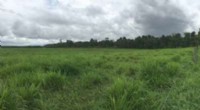
- De zon blokkeren om de opwarming van de aarde onder controle te houden
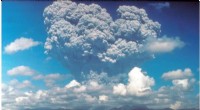
- Stop de houtkap na verstoring in bossen
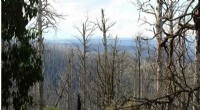
- Wat een gletsjerrivier onthult over de Groenlandse ijskap
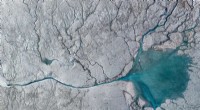
- Wetenschappers kijken naar de lucht om de detectie van tsunami's te verbeteren
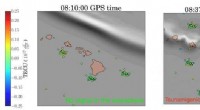
 Nanoslinky:een nieuwe nanofluïdische technologie voor DNA-manipulatie en -meting
Nanoslinky:een nieuwe nanofluïdische technologie voor DNA-manipulatie en -meting Studie identificeert de belangrijkste oorzaken van verandering in de oceaancirculatie
Studie identificeert de belangrijkste oorzaken van verandering in de oceaancirculatie Professor maakt visualisatietool voor klimaatgegevens die veranderingen in de atmosfeer in realtime kan onthullen
Professor maakt visualisatietool voor klimaatgegevens die veranderingen in de atmosfeer in realtime kan onthullen Tropical Rain Forest Biome Landscape Kenmerken
Tropical Rain Forest Biome Landscape Kenmerken  Scheepssporen laten zien hoe aerosols wolken snel en langzaam beïnvloeden
Scheepssporen laten zien hoe aerosols wolken snel en langzaam beïnvloeden Numeriek model lokaliseert bron van voorloper van seismische signalen
Numeriek model lokaliseert bron van voorloper van seismische signalen De politieke voorkeuren van bedrijven beïnvloeden de betrokkenheid bij activisten
De politieke voorkeuren van bedrijven beïnvloeden de betrokkenheid bij activisten Waarom door deuropeningen lopen ons doet vergeten
Waarom door deuropeningen lopen ons doet vergeten
- Elektronica
- Biologie
- Zonsverduistering
- Wiskunde
- French | Italian | Portuguese | Swedish | German | Dutch | Danish | Norway | Spanish |

-
Wetenschap © https://nl.scienceaq.com

